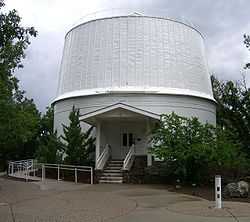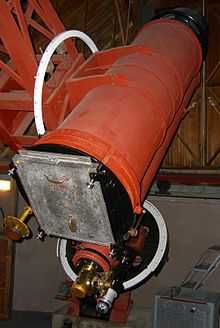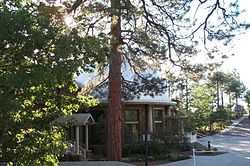Lowell Observatory
| Lowell Observatory | |||||||||||||||||||||||||||||||||||||||||||||||||||
|---|---|---|---|---|---|---|---|---|---|---|---|---|---|---|---|---|---|---|---|---|---|---|---|---|---|---|---|---|---|---|---|---|---|---|---|---|---|---|---|---|---|---|---|---|---|---|---|---|---|---|---|
 The Clark Telescope Dome on Mars Hill | |||||||||||||||||||||||||||||||||||||||||||||||||||
| Organization | Private institution | ||||||||||||||||||||||||||||||||||||||||||||||||||
| Code | 690 | ||||||||||||||||||||||||||||||||||||||||||||||||||
| Location | Flagstaff, Arizona | ||||||||||||||||||||||||||||||||||||||||||||||||||
Coordinates | |||||||||||||||||||||||||||||||||||||||||||||||||||
| Altitude | 2,210 m (7,250 ft) | ||||||||||||||||||||||||||||||||||||||||||||||||||
| Established | 1894 | ||||||||||||||||||||||||||||||||||||||||||||||||||
|
Website http://www.lowell.edu | |||||||||||||||||||||||||||||||||||||||||||||||||||
| |||||||||||||||||||||||||||||||||||||||||||||||||||
Lowell Observatory is an astronomical observatory in Flagstaff, Arizona, United States. Lowell Observatory was established in 1894, placing it among the oldest observatories in the United States, and was designated a National Historic Landmark in 1965.[2][3] In 2011, the Observatory was named one of "The World's 100 Most Important Places" by TIME.
The Observatory's original 61-centimeter (24-inch) Alvan Clark Telescope is still in use today for public education. Lowell Observatory hosts 85,000 visitors per year at their Steele Visitors Center, who take guided daytime tours and view various wonders of the night sky through the Clark Telescope and other telescopes. It was founded by astronomer Percival Lowell, and run for a time by his third cousin Guy Lowell of Boston's well-known Lowell family. The current trustee of Lowell Observatory is William Lowell Putnam III, grandnephew of founder Percival Lowell and son of long-time trustee Roger Putnam. The position of trustee is historically handed down through the family.
The observatory operates several telescopes at three locations in the Flagstaff area. The main facility, located on Mars Hill just west of downtown Flagstaff, houses the original 61-centimeter (24-inch) Clark Refracting Telescope, although its role today is as a public education tool and not research. The telescope, built in 1896 for $20,000, was assembled in Boston by Alvan Clark and then shipped by train to Flagstaff. Also located on the Mars Hill campus is the 33-centimeter (13-inch) Pluto Discovery Telescope, used by Clyde Tombaugh in 1930 to discover the dwarf planet Pluto.
Lowell Observatory currently operates four research telescopes at its Anderson Mesa dark sky site, located 20 km (12 mi) southeast of Flagstaff, including the 180-centimeter (72-inch) Perkins Telescope (in partnership with Boston University) and the 110-centimeter (42-inch) John S. Hall Telescope. Lowell is a partner with the United States Naval Observatory and Naval Research Laboratory in the Navy Precision Optical Interferometer (NPOI) also located at that site. The Observatory also operates smaller research telescopes at its historic site on Mars Hill and in Australia and Chile.
Past Anderson Mesa, on the peak of Happy Jack, Lowell Observatory has also built and is commissioning the 4.28-meter (169-inch) Discovery Channel Telescope in partnership with Discovery Communications, Inc.
History (see discoveries below)
Aside from the wide array of research and discoveries listed below, one science program carried out at the Observatory was the measurement of the variability of solar irradiance.[4] When Harold L. Johnson took over as the director in 1952, the stated objective became to focus on light from the Sun reflecting from Uranus and Neptune.[4] In 1953, the current 53 cm (21-inch) telescope was erected.[4] Beginning in 1954, this telescope began monitoring the brightness of these two planets, and comparing these measurements with a reference set of sunlike stars.[4]
-

Percival Lowell in the observer's chair of the Alvan Clark 61 cm (24-inch) refractor
-

Alvan Clark refractor telescope, the first permanent telescope at Lowell Observatory
-

33 cm (13-inch) astrograph used to discover Pluto
Discovery Channel Telescope (DCT)

Lowell Observatory is building a major new reflecting telescope in partnership with Discovery Communications, located near Happy Jack, Arizona. This Discovery Channel Telescope (DCT), located within the Mogollon Rim Ranger District of the Coconino National Forest, is expected to be the fifth-largest telescope in the contiguous United States, and it will enable the astronomers of Lowell Observatory to enter new research areas deeper into outer space.
The DCT and the research carried out there will be the focus of ongoing informative and educational television programs about astronomy, the sciences, and technology to be telecast on the Discovery channels. The primary mirror of the Discovery Channel Telescope will be 4.28 m (169 in) in diameter. It will be supposely notable for its uncommon meniscus design for such a large mirror. This mirror was ground and polished into its parabolic shape at the Optical Fabrication and Engineering Facility of the College of Optical Sciences of the University of Arizona (in Tucson, Arizona).
Current research
Lowell Observatory's astronomers conduct research on a wide range of solar system and astrophysical topics using ground-based, airborne, and space-based telescopes. Among the many current programs are a search for near-Earth asteroids, a survey of the Kuiper Belt beyond Neptune, a search for extrasolar planets, a decades-long study of the brightness stability of the sun, and a variety of investigations of star formation and other processes in distant galaxies. In addition, the Observatory staff designs and builds custom instrumentation for use on Lowell's telescopes and elsewhere. For example, Lowell staff built a sophisticated high-speed camera for use on the Stratospheric Observatory for Infrared Astronomy (SOFIA). SOFIA is a joint project of the United States and German space agencies and consists of a 2.5-meter (8.2-foot) telescope on board a Boeing 747 SP.
Notable discoveries
- The dwarf planet Pluto by Clyde Tombaugh in 1930
- Large recessional velocities of galaxies by Vesto Melvin Slipher between 1912 and 1914 (that led ultimately to the realization our universe is expanding)
- Co-discovery of the rings of Uranus in 1977
- The periodic variation in the activity of Comet Halley during the 1985/1986 apparition[5]
- The three largest known stars
- The atmosphere of Pluto
- Accurate orbits for two of Pluto's moons: Nix and Hydra
- Oxygen on Jupiter's satellite Ganymede
- Carbon dioxide ice on three Uranian satellites
- The first Trojan of Neptune
- Evidence that the atmosphere of HD 209458 b contains water vapour
See also
- List largest optical telescopes in the continental United States
References
- ↑ "National Register Information System". National Register of Historic Places. National Park Service. 2007-01-23.
- ↑ 2.0 2.1 "Lowell Observatory". National Historic Landmark summary listing. National Park Service. Retrieved 2007-09-27.
- ↑ Marilynn Larew (October 31, 1977). National Register of Historic Places Inventory-Nomination: Lowell Observatory (PDF). National Park Service. Retrieved 2009-05-05. and Accompanying six photos, exterior, from 1964 and 1976
- ↑ 4.0 4.1 4.2 4.3 Wotkyns, Steele (2006). "Lowell Observatory's 21-inch Telescope Delivering Long-Term Results". Reflector (the Astronomical League). LVIII (2): 16.
- ↑ Schleicher, David G.; Millis, Robert L.; Thompson, Don T.; Birch, Peter V.; Martin, Ralph et al. (1990). "Periodic variations in the activity of Comet P/Halley during the 1985/1986 apparition". Astronomical Journal 100: 896–912. Bibcode:1990AJ....100..896S. doi:10.1086/115570.
Sources
- Strauss D. (1994). "Lowell, Percival, Pickering, W.H. and the founding of the Lowell Observatory". Annals of Science 51 (1): 37–58. doi:10.1080/00033799400200121.
- David Strauss, Percival Lowell: The Culture and Science of a Boston Brahmin (Cambridge: Harvard University Press, 2001)
- William Graves Hoyt, Lowell and Mars (Tucson: University of Arizona Press, 1976)
- William Lowell Putnam, The Explorers of Mars Hill: A Centennial History of Lowell Observatory, 1894-1994 (New Hampshire: Phoenix Publishing, 1994)
External links
| Wikimedia Commons has media related to Lowell Observatory. |
- Lowell Observatory
- Discovery Channel Telescope
- Flagstaff Clear Sky Clock Forecasts of observing conditions covering Lowell Observatory.
- National Historic Landmarks Program: Lowell Observatory+
- Lowell Observatory, 1400 West Mars Hill Road, Flagstaff, Coconino, AZ at the Historic American Buildings Survey (HABS), with additional material , , , , ,
